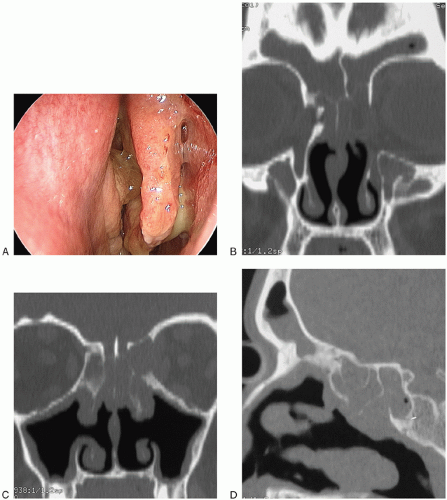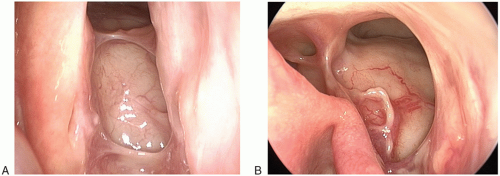Extended Frontal Sinusotomy—Draf Iii Or Median Drainage Procedure (MDP)
Daniel B. Simmen
INTRODUCTION
The endoscopic frontal recess approach is the primary technique for managing frontal sinus pathology. The goal is to achieve patency and drainage of the sinus. Preservation of the mucus membrane of the frontal recess will help to reduce scarring of the drainage pathway. Unfortunately, this is not always possible. The frontal sinus is especially prone to scarring and stenosis after surgery, and if that occurs, then more extended approaches are needed to solve such problems.
Successful surgery starts with proper patient selection and medical management prior to the surgery. As important as the surgical technique is the long-term postoperative medical management, including endoscopic debridement if necessary. Revision endoscopic sinus surgery of recalcitrant frontal sinus disease is one of the most difficult operations in this area. The challenging anatomy along with some specific medical comorbidities makes it a challenge for the surgeon to choose the best approach to treat the pathology.
Over the past two decades, there has been an evolution from external and obliterative techniques toward more extensive endoscopic frontal sinusotomy techniques to try to reduce the morbidity associated with external procedures. The median frontal sinus drainage procedure involves endonasal resection of the frontal intersinus septum, as well as the floor of the frontal sinus with the adjacent bony nasal septum anterior to the cribriform plate. The principle difference between the classic external (Jansen, Lothrop, Ritter, Lynch and Howarth) operations is that the bony borders around the drainage pathways are preserved and circumferential stripping of mucosa is reduced in the median drainage procedure (MDP), and this makes it more likely that the frontal sinus outflow pathway will stay patent in the long term.
Median Frontal Sinus Drainage Procedure—MDP (Endoscopic Modified Lothrop Procedure [EMLP] or Draf III)
This procedure consists of opening the frontal recesses and removing the bone between them by enlarging the central drainage channel. With this extension over the midline, the surgeon can achieve the most extensive pathway possible for both frontal sinuses at the same time. To best achieve this goal, the surgeon also has to remove the posterior aspect of the anterior wall of the frontal bone, which is very thick and is known as “the beak”—the posterior part of the nasal process of the frontal bone. Finally, the superior aspect of the septum, anterior to the middle turbinate, is removed to allow drainage of both sinuses at the same time. This is the most extensive possible frontal sinusotomy, a median frontal sinus drainage procedure, MDP or Draf III.
Modifications—Extended Sinusotomy
Draf IIa is an extended drainage procedure that involves opening the frontal recess (“uncapping the egg,” see Chapter 17) between the lamina papyracea and the middle turbinate or even more extended to the nasal septum and intersinus septum
Draf IIb. The anterior portion and attachment to the lateral nasal wall region (agger nasi) is therefore resected allowing a wide unilateral drainage pathway from the frontal sinus (Fig. 18.1A and B).
HISTORY
These patients usually have a history of previous sinus surgery that has led to obstruction of the frontonasal recess. Primary chronic or recurrent acute frontal sinusitis is very uncommon, and a diagnosis of frontal sinusitis should be made with caution. All too often, it transpires on reviewing the history and previous preoperative imaging that the surgery done to the frontal sinus was done for the wrong reasons and that patients had tension-type headache, migraine, or variants of vascular headache. Their surgery may have been done for idiopathic nasal polyposis that had not responded to medical treatment, and the surgery may have inadvertently damaged the mucosa of the frontonasal recess and caused stenosis. It is interesting that most patients with idiopathic nasal polyps have polyps that do not originate within the frontal sinus itself, and when they do occur in the infundibulum of the frontal sinus, they expand and widen the frontal recess. A reduced or loss of the sense of smell is an important sign of residual disease and is a strong indicator that the previous surgery has not addressed frontal sinus or ethmoid disease adequately. The same is true for patients with frontal pressure especially when flying or diving. If the patient reports severe facial pain with no further symptoms of inflammatory sinus disease, one has to be very cautious with the indication for an extended sinusotomy. All too frequently, pain in or around the frontal sinuses is attributed to sinusitis when this is rare. Patients should have a clear association among their symptoms, endoscopic signs, and radiologic changes as well as a failure to respond to medical treatment before an instrument goes near their frontal recess. If topical and systemic treatment including the use of oral steroids fails to control their symptoms, then sinus surgery is indicated.
The MDP is very helpful in demarcating the anterior limit of the anterior skull base tumors and is an integral part of endonasal skull base surgery to approach these pathologies to optimize exposure before resecting the tumor from the skull base.
PHYSICAL EXAMINATION
Endoscopically, one usually defines whether there has been previous sinus surgery or there is evidence of persistent sinus disease in the area of the frontal recess. A typical finding is a trimmed middle turbinate that has lateralized and scarred the drainage pathway of the frontal sinus. In patients with chronic rhinosinusitis (CRS) without nasal polyps, the area is usually covered with crusts and a mucopurulent discharge can be identified. It is preferable to inspect the nasal cavity with a 45-degree endoscope. It is of upmost importance to evaluate the endoscopic changes after medical treatment and to define the optimal timing for their radiologic imaging. For the upcoming surgery, one should not only investigate the intranasal anatomy but also evaluate for a high anterior septal deviation that will make the approach very difficult and which will require correction during surgery.
Some frontal sinus problems are secondary to previous intervention where an incorrect diagnosis of frontal sinusitis was made and the frontal recess was operated on unnecessarily. If there is any doubt about the diagnosis and there are no abnormal endoscopic findings, it is very helpful to see the patients when they are symptomatic and then examine them endoscopically. Frequently, they are found not to have any purulent secretions so that a diagnosis of migraine or one of its variants can be accurately made.
INDICATIONS
Indications for a MDP (Draf III)
Stenosis of the frontal recess secondary to previous surgery.
Significant new bone formation—“osteitis”—after functional endoscopic sinus surgery.
In severe polyposis associated with aspirin sensitivity after early marked recurrence (Fig. 18.2A-D).
Collapse of the lateral wall of the frontal recess. This is usually secondary to an external frontoethmoidectomy, but it can occur because a mucocele or other pathology has eroded bone.
Specific pathology in the frontal sinus such as neoplasms and allergic fungal sinusitis.

FIGURE 18.2 A-D: Endoscopic view (A) and CT scan (B-D) of a severe nasal polyposis and osteitis in a typical revision case that qualifies for an operation including a Draf III, MDP operation.
Access can be achieved more laterally in the frontal sinus using an angled endoscope and by placing it in one nasal airway to allow it to cross the midline above the remains of the septum into the frontal sinus on the other side.
A MDP allows for anterior control during the resection of skull base tumors which lie medial to the pupillary line.
Patient Selection and Indications for a Draf IIb
Overall, it is difficult to state in which situation a Draf IIb is indicated and in which situation a Draf III is the better first-line option. If you look at the indications for a Draf III, most of them would qualify also for a Draf IIb—it is of upmost importance to evaluate the anatomy first—if there is a very narrow anatomic situation in the coronal as well as in the sagittal plane, one should consider a Draf III as the better option. Also take into account the pathology, and often the largest opening and drainage pathway is the best way to go. Only if the anatomy is favorable and the pathology is not that severe can you consider initially performing a Draf IIb.
Indication for a Draf IIb
In very selected cases with moderate pathology and anatomically ideal parameters, especially the distance between the back wall and the beak allows adequate drainage.
Contraindications for a MDP (Draf III)
If there has been a previous external approach, then scar tissue can cause a lateral loculation and these may not be accessible by a MDP or are very likely to recur. This is particularly likely to occur if the bony framework has been lost.
If the anteroposterior diameter of the frontal sinus is small or if there is marked osteitis, then while it may be possible to open the frontal sinus at surgery, other factors may lead to stenosis.
A poorly pneumatized frontal sinus on both sides.
A CSF leak that is placed lateral to the pupillary line.
Beware that frontal pain, particularly after the patient has had surgery, is often attributed to sinusitis. All too often, it is due to tension-type headache or neuropathic pain following previous surgery.
Lack of experience and/or proper instrumentation.
PREOPERATIVE PLANNING
First of all, the underlying pathology must be treated medically before planning imaging. After medical treatment, a computed tomography (CT) is carried out in all cases, and only in specific indications an additional MRI is added to the investigation. These include patients with a tumor when it helps to know if lateral opacification of the sinus is due to retained secretions or tumor as this will influence whether or not it can be removed endoscopically. Recent significant advances in CT have made the demonstration of this complex anatomy easier. This improvement in image clarity and multiplanar views of the frontal sinus allows definition of the individual anatomy in detail. The primary goal for the surgeon is to understand and plan the surgery with these variations in mind prior to the operation.




